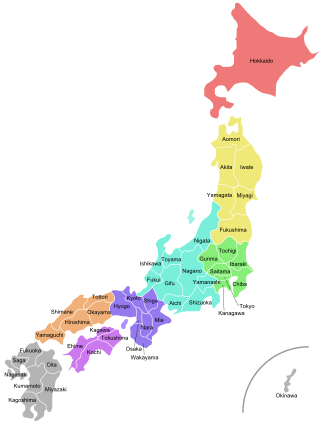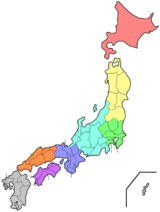
Japan is divided into 47 prefectures, which rank immediately below the national government and form the country's first level of jurisdiction and administrative division. They include 43 prefectures proper, two urban prefectures, one regional prefecture and one metropolis. In 1868, the Meiji Fuhanken sanchisei administration created the first prefectures to replace the urban and rural administrators in the parts of the country previously controlled directly by the shogunate and a few territories of rebels/shogunate loyalists who had not submitted to the new government such as Aizu/Wakamatsu. In 1871, all remaining feudal domains (han) were also transformed into prefectures, so that prefectures subdivided the whole country. In several waves of territorial consolidation, today's 47 prefectures were formed by the turn of the century. In many instances, these are contiguous with the ancient ritsuryō provinces of Japan.

Nara Prefecture is a prefecture of Japan located in the Kansai region of Honshu. As of 2020, Nara Prefecture has a population of 1,321,805 and has a geographic area of 3,691 square kilometres (1,425 sq mi). Nara Prefecture borders Kyoto Prefecture to the north, Osaka Prefecture to the northwest, Wakayama Prefecture to the southwest, and Mie Prefecture to the east.

Special wards are a special form of municipalities in Japan under the 1947 Local Autonomy Law. They are city-level wards: primary subdivisions of a prefecture with municipal autonomy largely comparable to other forms of municipalities.

Umeda is a major commercial, business, shopping and entertainment district in Kita-ku, Osaka, Japan, and the city's main northern railway terminus. The district's name means "plum field".

The Japanese political process has two types of elections.

The Tokyo Metropolitan Government is the government of the Tokyo Metropolis. One of the 47 prefectures of Japan, the government consists of a popularly elected governor and assembly. The headquarters building is located in the ward of Shinjuku. The metropolitan government administers the special wards, cities, towns and villages that constitute part of the Tokyo Metropolis. With a population closing in on 14 million living within its boundaries, and many more commuting from neighbouring prefectures, the metropolitan government wields significant political power within Japan.
The Osaka Restoration Association, also referred to as One Osaka, is a regional political party in Osaka Prefecture, Japan. Founded in 2010 by then-Governor Tōru Hashimoto, its main platform is pursuing the Osaka Metropolis plan of merging the prefecture and some of its cities into "One Osaka", reducing overlapping bureaucratic organizations of the prefecture and the city of Osaka, towards Dōshūsei.
The 17th unified local elections in Japan took place in April 2011. In the first phase on April 10, 2011, 12 governors, 41 prefectural assemblies as well as five mayors and 15 assemblies in cities designated by government ordinance were elected. In the second phase on April 24, 2011, mayors and assemblies in hundreds of cities, "special wards" of Tokyo, towns, and villages were up for election. Additionally, a by-election for the National Diet was held in Aichi on April 24.
Politics of Kanagawa, as in all prefectures of Japan, takes place in the framework of local autonomy that is guaranteed by the Constitution and laid out in the Local Autonomy Law. The administration is headed by a governor directly elected by the people every four years in first-past-the-post elections. Legislation, the budget and the approval of personnel appointments, including the vice governors, are handled by the prefectural assembly that is directly elected by the people every four years by single-non transferable vote.
The politics of Tokyo City, as the capital of the Empire of Japan, took place under special regulations that limited its local autonomy compared to other municipalities in Japan. In 1943, the city's independent institutions were eliminated altogether under the authoritarian Tōjō cabinet and the administration was absorbed by the appointed government of Tokyo prefecture.

The Osaka Metropolis Plan or Osaka Metropolis was a plan to transform Osaka Prefecture from a fu, an urban prefecture, into a to, a metropolis. Under the initially envisioned plan, Osaka city, Sakai city, and other surrounding cities in Osaka prefecture, were to be dissolved and – similarly to the special wards of Tokyo – subdivided into special wards which had a status as municipalities but left some municipal tasks and revenues to the prefectural administration. As political resistance grew, notably the opposition to the plan in Sakai City expressed in the 2013 mayoral election, the concrete plan was reduced to, at least as a first step, only abolishing Osaka City. As in Tokyo, the metropolis would have continued to include all other municipalities of the prefecture and served as a prefectural government for them.
Politics of Osaka, as in all 47 prefectures of Japan, takes place in the framework of local autonomy that is guaranteed by chapter 8 of the Constitution and laid out in the Local Autonomy Law. The administration is headed by a governor directly elected by the people every four years in first-past-the-post elections. Legislation, the budget and the approval of personnel appointments, including the vice governors, are handled by the prefectural assembly that is directly elected by the people every four years by single-non transferable vote.
Politics of Osaka City, as in all municipalities of Japan, takes place in the framework of local autonomy that is guaranteed by chapter 8 of the Constitution and laid out in the Local Autonomy Law. As one of Japan's 20 major cities designated by government ordinance, Osaka City has some administrative responsibilities that are handled by the prefectures in ordinary municipalities and is subdivided into wards.

The Mie Prefectural Assembly is the prefectural parliament of Mie.

The Aichi Prefectural Assembly is the legislative assembly of Aichi Prefecture.
The first stage of the 18th unified local elections in Japan took place on April 12, 2015. The Liberal Democratic Party under leadership of Shinzo Abe was the overall victor, winning many races including all ten gubernatorial races and 1,153 of the 2,284 assembly seats at stake. Further elections for municipal mayors and assemblies took place on April 26.

The Hyogo at-large district is a constituency that represents Hyogo Prefecture in the House of Councillors in the Diet of Japan. It currently has five Councillors in the 242-member house, but this representation will increase to six by July 2019.

The Hyogo Prefectural Assembly is the prefectural parliament of Hyōgo Prefecture.

The Osaka City Council is the legislature of Osaka City. It is responsible for the "enactment, amendment and repeal of ordinances, budgetary decisions, approval of account settlements, matters of financial importances including acquisition and disposal of city assets, and others." The assembly has a regular membership 81 members, with 41 needed to form a majority.

The 2019 Osaka Prefectural Assembly Election was held on 7 April to elect the 88 members of the Osaka Prefectural Assembly.

















